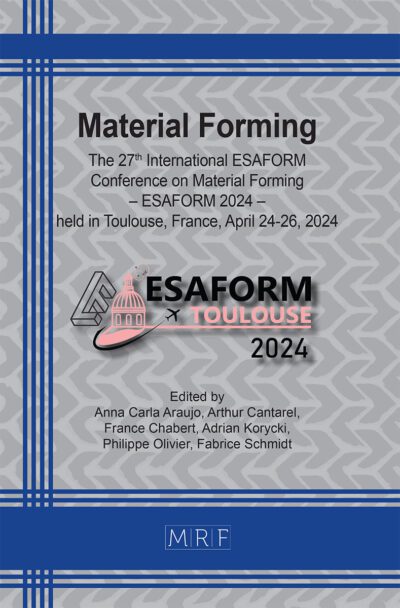Predicting optimal L-PBF printing location according to desired part quality: A data-driven methodology
Gabriele Locatelli, Mariangela Quarto, Gianluca D’Urso, Claudio Giardini
Abstract. The influence of print position on final quality cannot be neglected when parts are fabricated by laser-powder bed fusion (L-PBF) additive manufacturing technique. Several studies investigated this topic, focusing mainly on critical locations, but without mapping build platforms. Due to the availability of many L-PBF system architectures and processable materials on the market, it is imperative to define a simple, scalable, and easily adaptable mapping approach. This article thus proposes an innovative and scalable methodology to map the spatial performance of L-PBF printing platforms. The presented approach exploits experiments and natural-neighbor interpolation/extrapolation to map powder bed areas complying with two sets of dimensional and surface roughness tolerances. Regions where parts comply with desired design requirements are successively identified through classification. A demonstration is provided by applying the methodology to 316L stainless steel. The predictive maps in output reveal patterns consistent with known challenges in L-PBF additive manufacturing, underlining the importance of strategic positioning of critical components and the potential for adaptive process parameter optimization. Specifically, the predictive maps supply useful information for optimizing the print position reducing the need for post-processing. The suggested solution is practical for improving process efficiency and reducing waste and is simply adaptable to different material-machine combinations.
Keywords
L-PBF, Powder Bed Fusion, Part Location, Stainless Steel, Spatial Analysis
Published online 5/7/2025, 10 pages
Copyright © 2025 by the author(s)
Published under license by Materials Research Forum LLC., Millersville PA, USA
Citation: Gabriele Locatelli, Mariangela Quarto, Gianluca D’Urso, Claudio Giardini, Predicting optimal L-PBF printing location according to desired part quality: A data-driven methodology, Materials Research Proceedings, Vol. 54, pp 170-179, 2025
DOI: https://doi.org/10.21741/9781644903599-19
The article was published as article 19 of the book Material Forming
![]() Content from this work may be used under the terms of the Creative Commons Attribution 3.0 license. Any further distribution of this work must maintain attribution to the author(s) and the title of the work, journal citation and DOI.
Content from this work may be used under the terms of the Creative Commons Attribution 3.0 license. Any further distribution of this work must maintain attribution to the author(s) and the title of the work, journal citation and DOI.
References
[1] L.E.J. Thomas-Seale, J.C. Kirkman-Brown, M.M. Attallah, D.M. Espino, D.E.T. Shepherd, The barriers to the progression of additive manufacture: Perspectives from UK industry, Int. J. Prod. Econ. 198 (2018) 104-118. https://doi.org/10.1016/j.ijpe.2018.02.003
[2] H. Gong, K. Rafi, H. Gu, T. Starr, B. Stucker, Analysis of defect generation in Ti–6Al–4V parts made using powder bed fusion additive manufacturing processes, Addit. Manuf. 1-4 (2014) 87-98. https://doi.org/10.1016/j.addma.2014.08.002
[3] M. Mounaud, F. Thiebaut, P. Bourdet, H. Falgarone, N. Chevassus, Assembly sequence influence on geometric deviations propagation of compliant parts, Int. J. Prod. Res. 49 (2011) 1021 – 1043. https://doi.org/10.1080/00207540903460240
[4] B. Schleich, S. Wartzack, How to determine the influence of geometric deviations on elastic deformations and the structural performance?, Proc. Inst. Mech. Eng. B. 227 (2013) 754-764. https://doi.org/10.1177/0954405412468994
[5] N. Sanaei, A. Fatemi, Analysis of the effect of surface roughness on fatigue performance of powder bed fusion additive manufactured metals, Theor. Appl. Fract. Mech. 108 (2020) 102638. https://doi.org/10.1016/j.tafmec.2020.102638
[6] M. Melia, J. Duran, J. Koepke, D. Saiz, B. Jared, E. Schindelholz, How build angle and post-processing impact roughness and corrosion of additively manufactured 316L stainless steel, npj Mater. Degrad. 4 (2020) 1-11. https://doi.org/10.1038/s41529-020-00126-5
[7] J. Reijonen, A. Revuelta, T. Riipinen, K. Ruusuvuori, P. Puukko, On the effect of shielding gas flow on porosity and melt pool geometry in laser powder bed fusion additive manufacturing, Addit. Manuf. 32 (2020) 101030. https://doi.org/10.1016/j.addma.2019.101030
[8] K. Chua, Y. Choong, C. Wong, Investigation of the effects on the print location during selective laser melting process, Proceedings of the 3rd International Conference on Progress in Additive Manufacturing (Pro‑AM 2018) 613‑618. https://doi.org/10.25341/D4Q30B
[9] D. Croccolo, M. De Agostinis, S. Fini, G. Olmi, N. Bogojevic, S. Ciric-Kostic, Effects of build orientation and thickness of allowance on the fatigue behaviour of 15–5 PH stainless steel manufactured by DMLS, Fatigue Fract. Eng. Mater. Struct. 41 (2018) 900-916. https://doi.org/10.1111/ffe.12737
[10] A. Ladewig, G. Schlick, M. Fisser, V. Schulze, U. Glatzel, Influence of the shielding gas flow on the removal of process by-products in the selective laser melting process, Addit. Manuf. 10 (2016) 1-9. https://doi.org/10.1016/j.addma.2016.01.004
[11] D. Yao, X. An, H. Fu, H. Zhang, X. Yang, Q. Zou, K. Dong, Dynamic investigation on the powder spreading during selective laser melting additive manufacturing, Addit. Manuf. 37 (2021) 101707. https://doi.org/10.1016/j.addma.2020.101707
[12] F. Calignano, Investigation of the accuracy and roughness in the laser powder bed fusion process, Virtual Phys. Prototyp. 13 (2018) 97-104. https://doi.org/10.1080/17452759.2018.1426368
[13] J. Veetil, M. Khorasani, A. Ghasemi, B. Rolfe, I. Vrooijink, K. Van Beurden, S. Moes, I. Gibson, Build position-based dimensional deviations of laser powder-bed fusion of stainless steel 316L, Precis. Eng. 67 (2021) 58-68. https://doi.org/10.1016/j.precisioneng.2020.09.024
[14] R. Sibson. A brief description of natural neighbour interpolation, in: V. Barnet (Eds.), Interpreting Multivariate Data, John Wiley & Sons, Chichester, 1981, pp. 21-36. https://doi.org/10.2307/2981496
[15] R. Sibson, A vector identity for the Dirichlet tessellation, Math. Proc. Camb. Philos. Soc. 87 (1980), 151-155. https://doi.org/10.1017/S0305004100056589
[16] I. Amidror, Scattered data interpolation methods for electronic imaging systems: a survey, Journal of Electronic Imaging 11 (2002). https://doi.org/10.1117/1.1455013
[17] T. Bobach, G. Farin, D. Hansford, G. Umlauf, Natural neighbor extrapolation using ghost points, Comput. Aided Des. 41 (2009), 350-365. http://dx.doi.org/10.1016/j.cad.2008.08.007
[18] S. Rott, A. Ladewig, K. Friedberger, J. Casper, M. Full, J. Schleifenbaum, Surface roughness in laser powder bed fusion – Interdependency of surface orientation and laser incidence, Addit. Manuf. 36 (2020) 101437. https://doi.org/10.1016/j.addma.2020.101437
[19] ISO 2768:1989. General tolerances. International Organization for Standardization: Geneva, Switzerland, 1989.
[20] Information on https://www.mathworks.com













